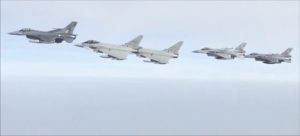
Allied and partner fighter and support aircraft took to the skies the morning of September 21 to start their training flights in the Baltic region.
Italian Eurofighters took off from Šiauliai, Lithuania and were joined by Portuguese and Polish F-16s flying in from Poland to conduct aerial combat drills in a specially segregated training area. Meanwhile an Estonian M-28 transport plane took off from Ämari, Estonia, to simulate a loss of communications in Finnish airspace, where it was intercepted by Finnish F-18s, escorted and handed over to German Eurofighters – also from Ämari. The M-28 then continued to simulate a crash landing and triggered the national rescue and response. A group of Estonian media were on-board the M-28 and witnessed the simulated procedures.
A Royal Netherlands Air Force KDC-10 tanker aircraft conducted air-to-air refuelling with Polish F-16 fighters, Finnish and Swedish fighters were involved in air-to-air maneouvres and the German Eurofighters flew Close Air Support missions for Estonian Joint Tactical Air Controllers.
These complex training scenarios provide important practice for all Allies and regional Partners. The simulated situations may happen anytime and it is important for all participants to be coordinated in how they apply tactics, techniques and procedures across national borders.
“Regular training and cooperation with our regional Allies and partners is essential to ensure we have an effective force in place to safeguard the Baltic Region,” said Allied Air Command Deputy Chief of Staff Operations, U.S. Air Force Brigadier General Andrew Hansen. “I am confident that this will be another successful hands-on training event here in the Baltic States,” he added.
All players were highly focused on the training. In addition to their exercise involvement German Air Force fighters were scrambled by Combined Air Operations Centre Uedem to launch for a real-world NATO Air Policing mission, meeting and escorting a formation of Russian military aircraft flying over international waters off the Baltic Allies’ coast.
The first day of exercise Ramstein Alloy offered all participants worthwhile training to increase the level of professionalism and cooperation. Day two added a NATO Airborne Warning and Control System aircraft to the players’ list. The AWACS aircraft is scheduled to control manoeuvres of multiple fighter aircraft and to conduct a flyover of Tallinn in the afternoon on its way home to Germany.


